
|
Three PhD and one master's degree were awarded to graduate students working for instruments of the TAO telescope!
Graduate students of the Department of Astronomy, Kentaro Asano, Mizuno Uchiyama and Ken Tateuchi were awarded the PhD degree, and Soya Todo the master's degree, who were the major development team members of SWIMS (a near infrared camera and multi-object spectrograph) and MIMIZUKU (a mid-infrared camera and spectrograph) of the TAO 6.5 m telescope. In particular, Asano, Uchiyama and Tateuchi visited Chile for five to eight times and made a great contribution to the promotion of the TAO project. We will introduce their brilliant research results in the following.
Near Infrared Instrument Development Team (miniTAO/ANIR, TAO/SWIMS)
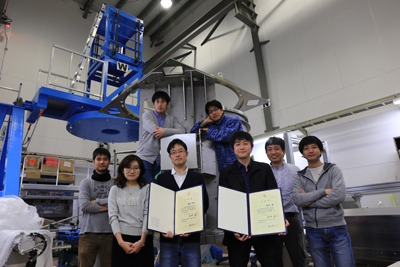
SWIMS development team members celebrating Tateuchi and Todo for their PhD and master's degree
Study of bulge properties in local luminous infrared galaxies based on ground-based hydrogen Paschen-α imaging survey
PhD Course,
Department of Astronomy, School of Science,
The University of Tokyo
TATEUCHI, Ken
|
I have successfully obtained PhD in science this March. I now recall this five years, devoting my life to the research at the institute of Astronomy, the University of Tokyo. I have mainly engaged in the University of Tokyo Atacama Observatory Project (TAO), and visited the telescope site in Chile many times for observations. Based on the data obtained there, I studied hard on it and made many presentations at international workshops. It is my honor to have them complied as a PhD thesis at last. TAO is a huge project where many people are working together towards the goals, and I am very pleased to be a part of it through my PhD thesis works.
Dissertation thesis (abstract)
Study of Bulge Properties in Local Luminous Infrared Galaxies Based on Ground-based Hydrogen Paschen-αImaging Survey
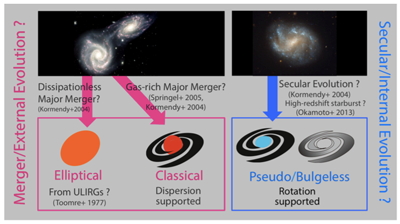
A diagram summarizing two theoretical predictions of the evolution of bulges. The left figure (pink) shows a scenario where a classical bulge is formed through a galaxy collision, and the right (blue) a scenario where a disky bulge (Pseudo bulge) is formed secularly without strong interaction.
As human face is different in every person, galaxies also have wide variety of faces (morphologies). Understanding how such diversity has been formed and acquired is important to solve the secret of formation / evolution of galaxies, which is one of the fundamental and biggest problems in astronomy. In a traditional morphological taxonomy, galaxies are roughly separated into two types, elliptical and spiral galaxies, and we have tried to explain their evolution process by a unified model conforming to "Hubble Classification". However, numerous observation and theories suggest that these evolution processes are separate, and this is now widely supported. In recent years, "Physical form taxonomy" has attracted attention as a new approach. This is not a judgment based on morphological appearance but a classification method based on the internal / external dynamics of galaxies. In this method, we focus on a 'bulge' which is thought to reflect the morphological history of galaxies well, and divide it into two classes of a classical bulge and a disky bulge (Pseudobulge) depending on its kinematics in which either dispersion or rotational movement dominates. Observationally, it is known that classical and disky bulges can be distinguished using Sérsic-Indexof their surface brightness profiles where "disky bulge is less than 2" and "classical bulge is greater than 2" (Fisher et al. 2008). Theoretical studies suggest that (1) elliptical galaxies are formed by galaxy collision / coalescence, (2) classical bulges are formed by galaxy collision / coalescence then a disk is reformed, (3) disky bulges are formed through secular evolution without interaction (Kormendy et al. 2004).
However, there is no observational evidence for such theoretical classification and evolutional scenario. One of the main reasons is that a nearby luminous infrared galaxy (LIRG), which is thought be a good sample (experiment site) to study active bulge formation, is strongly dimmed by its dust clouds and was difficult to study with the visible indices. Therefore, we decided to perform near-infrared Paα observations of nearby LIRGs using the Atacama Near InfraRed camera (ANIR) of the University of Tokyo miniTAO 1m telescope to spatially resolve star-formation activities in their bulges. Galaxies are aggregates of "stars (and star formation activity)", "dust", and "gas", which are dynamically interacting. Therefore, in this research, from the observation of U / LIRGs, we studied relations of these components to the "morphology (mechanical structure)" of the galaxies and compared them with theoretical predictions.
We have developed observation and analysis methods necessary for a Paα observation from the ground, which was thought to be difficult previously, and directly observed the star formation activity inside bulges of the U/LIRGs. In addition, for comprehensive understanding of LIRG including the dynamical movement of star formation, I have also engaged in a development of a next generation large instrument for TAO 6.5m telescope.
As a result, I have newly discovered that a classical bulge performs a compact star formation, and a disky bulge an extended star formation. This supports a theoretical scenario that the classical bulge is formed by a dramatic phenomenon such as a galaxy collision, and is the first observational evidence for it. A part of the result was published as a paper in the American magazine, Astrophysical Journal Supplement series in 2015. In addition, I have also worked for a development of the near-infrared imager/spectrograph (SWIMS) of the University of Tokyo Atacama Observatory Project (TAO Project) The development is now underway, and in FY2015 we are planning to bring this instrument to Subaru Telescope (Hawaii, USA) for observation. From its observations, we expect new discovery by clarifying connection between LIRGs' internal dynamics and their morphologies from the observation, and by putting observational restrictions on galaxy morphogenetic theory.
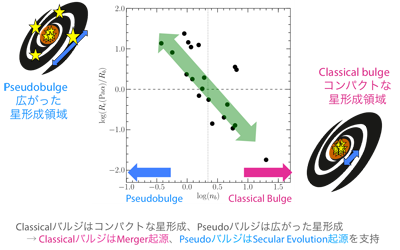
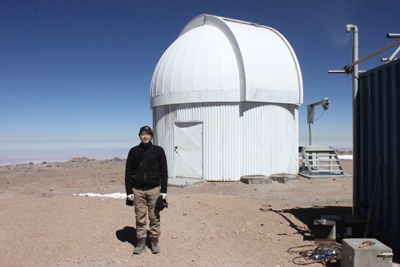
miniTAO Dome and Dr. Tateuchi
|
Development and evaluation of detector readout system in a near infrared multi-object camera and spectrograph SWIMS
Master Course, Department of Astronomy, School of Science,
The University of Tokyo
TODO, Soya
|
I developed and evaluated the detector readout system of SWIMS which is the 1st generation near infrared instrument of the TAO 6.5 m telescope, and summarized the results as my master thesis. SWIMS is an instrument capable of various observations with near-infrared light of a wavelength of 0.9 - 2.5 μm and has the power to unravel various mysteries of astronomy such as galaxy evolution. The detector readout system I have developed drives detectors that measures brightness of the infrared light and reads out images, and can be said to be the heart of the instrument.
In this research, I have developed hardware and software to integrate detectors and their readout circuits into SWIMS, that are the components of the detector readout system. Specifically, we have developed a readout cable that connects the detector and the readout circuit, and software to control the detector system from a PC. Despite the wide range of development items, thanks to the help of the SWIMS team, I was able to successfully develop a system that can drive detectors inside the SWIMS and read them out.
In order to confirm the performances of the system, the detectors were driven by a test setup and performance evaluation was carried out. In order to achieve scientific objectives with SWIMS, it is necessary for detectors to meet various demanding performance requirements. For example, there are read noise performances required to measure the brightness of infrared light with small error. Simply by turning on the power and driving it, the performance of the detectors cannot satisfy it, and try-and-error of adjusting various voltage values and setting of other parameters were done. Also, in order to suppress the readout noise, the hardware of detector readout system itself was devised to reduce the electromagnetic influence. As a result, we were finally able to achieve the requirement. Consequently, it was confirmed that the detector readout system I developed can be installed in SWIMS and used for its scientific observations.
Currently, development of SWIMS is ongoing, targeted at completion in 2015. After the completion, we are planning to bring it to the Subaru telescope at the summit of Mauna Kea in Hawaii first, and I hope to carry out observations to solve the mystery of galaxy evolution eventually.
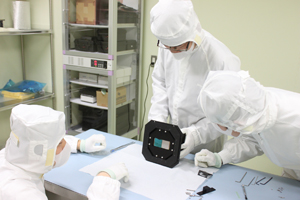
Assembly test of a detector holder (the author is at the center)
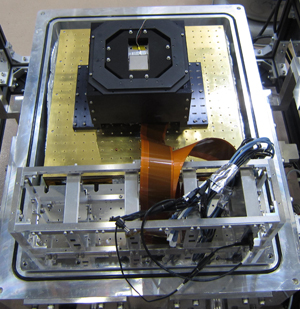
Detector performance evaluation test setup
|
Mid-infrared Detector Development Team (miniTAO/MAX38, TAO/MIMIZUKU)
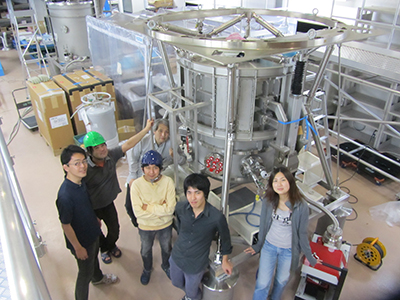
MIMIZUKU development team members with two doctoral degree holders in 2015
Mid-Infrared Studies of Cold Dust Distribution in Bipolar Planetary Nebulae
PhD Course, Department of Astronomy, School of Science,
The University of Tokyo
ASANO, Kentaro
|
Planetary nebulae are well-known as vivid and beautifully colored celestial objects. In the final stage of stellar evolution, small and medium mass stars from 1 to 8 sun mass become planetary nebulae. These are dying stars consisting of gas and dust nebulae. Before the planetary nebula phase, gas and dust were produced by the central star and ejected into outer space.We can see that their beautiful appearance, which is consists of the emissions from gas and dust illuminated by the light of the central star, has been mainly taken from visible light to near-infrared wavelengths. Especially butterfly-like shape and bipolar shape planetary nebulae have been frequently observed because of their beautiful shapes. However, the mechanism of shape formation is not known.
As an important key to reveal this problem, we focused on low temperature cosmic dust because most dust mass exists as low temperature dust. The temperature of ejected dust should be low temperature around 100 kelvin (~ -173 degree Celsius). The low temperature dust emits light at the longer than mid-infrared wavelength. Indeed, previous studies of spectroscopic observations showed the presence of large amounts of cold dust in bipolar planetary nebulae. However, it was hard to reveal the detail of the distribution of cold dust. This is due to the absence of telescopes and other instruments which can carry out the observations with high spatial resolution at mid-infrared.
In order to solve this problem, we developed the MAX38 as an instrument for mid-infrared astronomy. It was installed onto a miniTAO telescope which was built at the summit of Co. Chajnantor (at an altitude 5,640 m) in the Atacama desert. Thanks to the high altitude, it is much easier to observe objects in mid-infrared wavelength from the summit compared to observation from the ground. We have carried out observations at the site for nearly 300 days, since the miniTAO's first light in 2009. Our targets were three celestial bodies of NGC 6302, Mz 3, and Hb 5 which are famous for the brightest bipolar planetary nebula in southern area with longer mid-infrared wavelengths. Our study with images in 18, 25, 31, and 37-micron meters with MAX38/miniTAO revealed that most of the low temperature dust exists around the central star from 5,000 AU in all of our objects, and their distribution of cold dust is like the torus structure. In addition, our results clearly show that they had a very strong mass-loss along the equator surface. The mass-loss rate is about 100 times higher than the previous study predicted. This is important research in stellar evolution, suggesting the possibility that the bipolar shape formation occurred due to selective release of dust to the equator in the past.
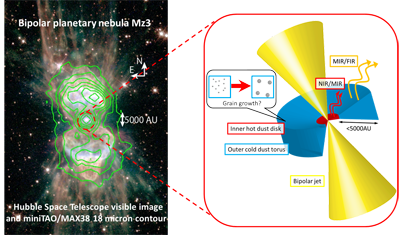
Left figure: A bipolar planetary nebula Mz 3 image obtained by Hubble Space Telescope at visible wavelength. The green contour line shows mid-infrared emissions at 18 micron obtained by miniTAO / MAX 38. Right figure: An imaginary view around the central star of the bipolar planetary nebula obtained from this study. It suggests the existence of a compact and dust torus spreading at a wide angle.
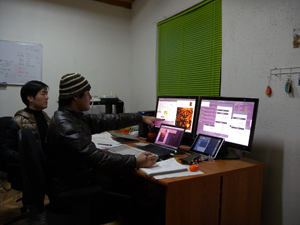
Dr. Asano, observing MiniTAO / MAX 38
|
Study of massive star formation in the mid-infrared
PhD Course, Department of Astronomy, School of Science,
The University of Tokyo
UCHIYAMA, Mizuho
|
In this study, we observed the three massive star forming regions M8E, RAFGL 6366S and IRAS 18317-0513 using the ground-based mid-infrared observation instrument MAX38 developed and operated by the miniTAO group. Forming massive stars are deeply embedded in dust and gas, and cannot be observed in the visible wavelengths, sometimes near infrared. Under these circumstances, the observation in the mid-infrared (5-50 micron), which has higher transmittance than visible light and near infrared and has higher spatial resolution than far infrared and radio wavelengths, can obtain detailed information on these objects. It is a very powerful observation tools to investigate the interaction between objects within the massive star forming region.In this research, the author herself traveled and participated in the observation of MAX 38 mounted on the miniTAO 1 m telescope in Atacama, Chile.
Each observed region had never been observed in the long mid-infrared (25-50 micron). In this study, images of each observed region were obtained at 31 micron and 37 micron for the first time, and a structure composed of multiple objects in all regions was detected. As a result, the spectral energy distribution of each object in each region was calculated, and the bolometric luminosity and mass of each object were individually obtained for the first time. Combining with the previous research investigating the evolutionary stage of each object, it was found that the less massive objects are more evolved in 2 out of 3 regions. If star formation begins simultaneously in a star forming region, heavier stars are formed in a shorter time. Therefore, assuming that objects formed at the same time in the observed region, it will contradict with the above observational result. In other words, in the two massive star forming regions observed this time, the less massive objects are made ahead of the more massive ones.In order to increase the number of samples, we searched literatures and found three other massive star formation regions similarly observed, but without the long mid-infrared observation. As a whole, in 3 out of 6 regions, it is indicated that less massive objects were made ahead of more massive ones. Also, none of the regions suggests that a massive object would formed first.
Considering the formation of massive stars, how to form massive cores that becomes massive stars are a critical problem in low-temperature, high-density molecular clouds. This is because it can only make up to the core with about the solar mass as it is in a low temperature and high density molecular cloud. The tendency that less massive objects formed first suggests one scenario that radiation and outflows from forming less massive objects influence the surrounding molecular clouds, and as a result, an environment where massive stars can be formed is prepared.
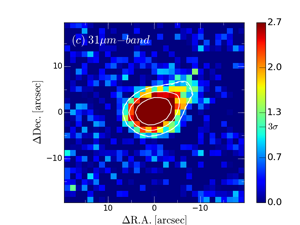
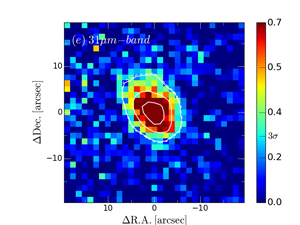
Images of M8E (top) and RAFGL 6366S (bottom) at 31um, An elongated structure considered to be composed of multiple objects can be seen
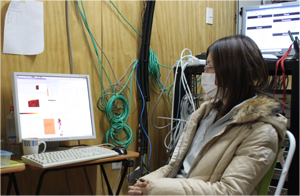
Dr. Uchiyama observing miniTAO / MAX
|
|











